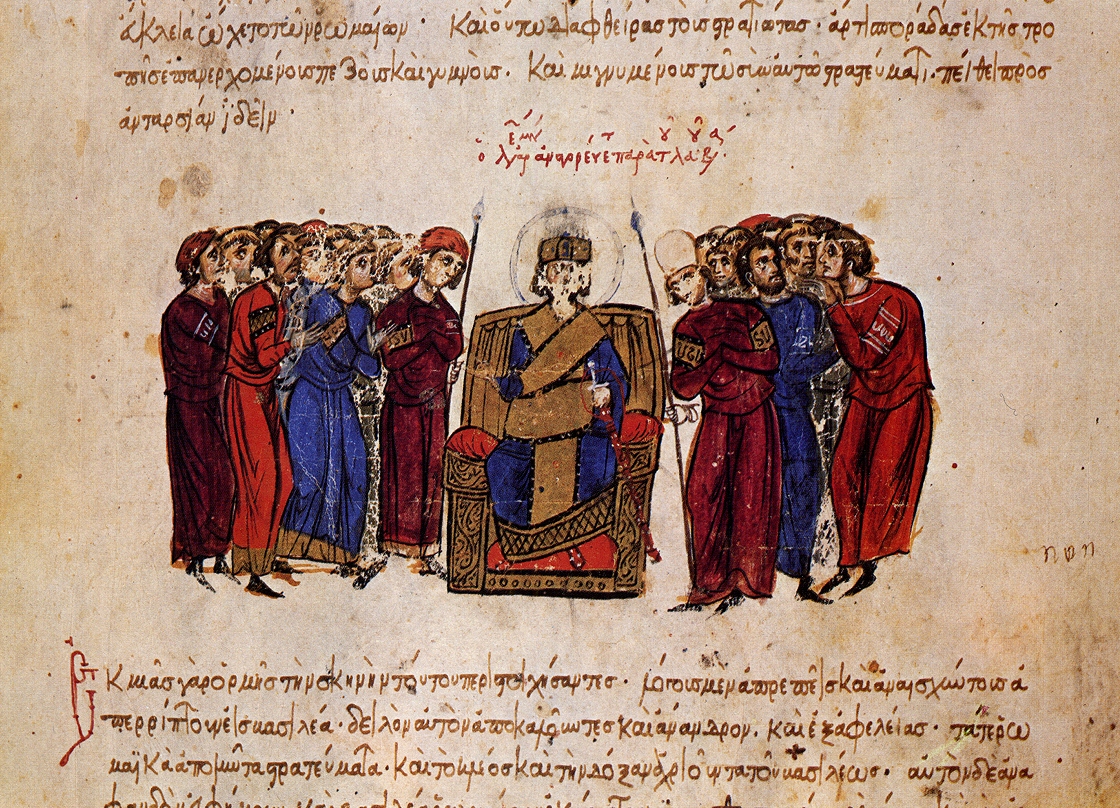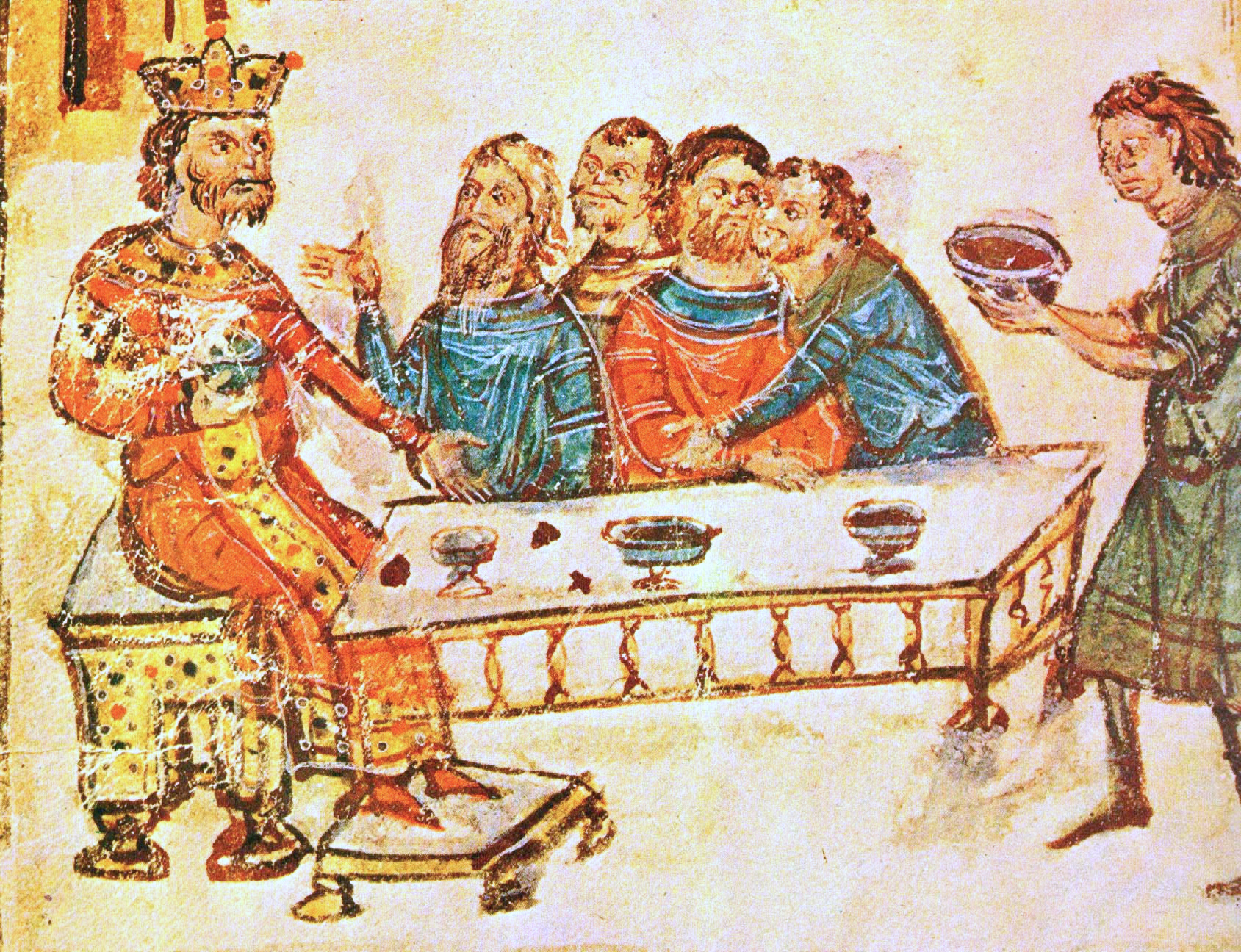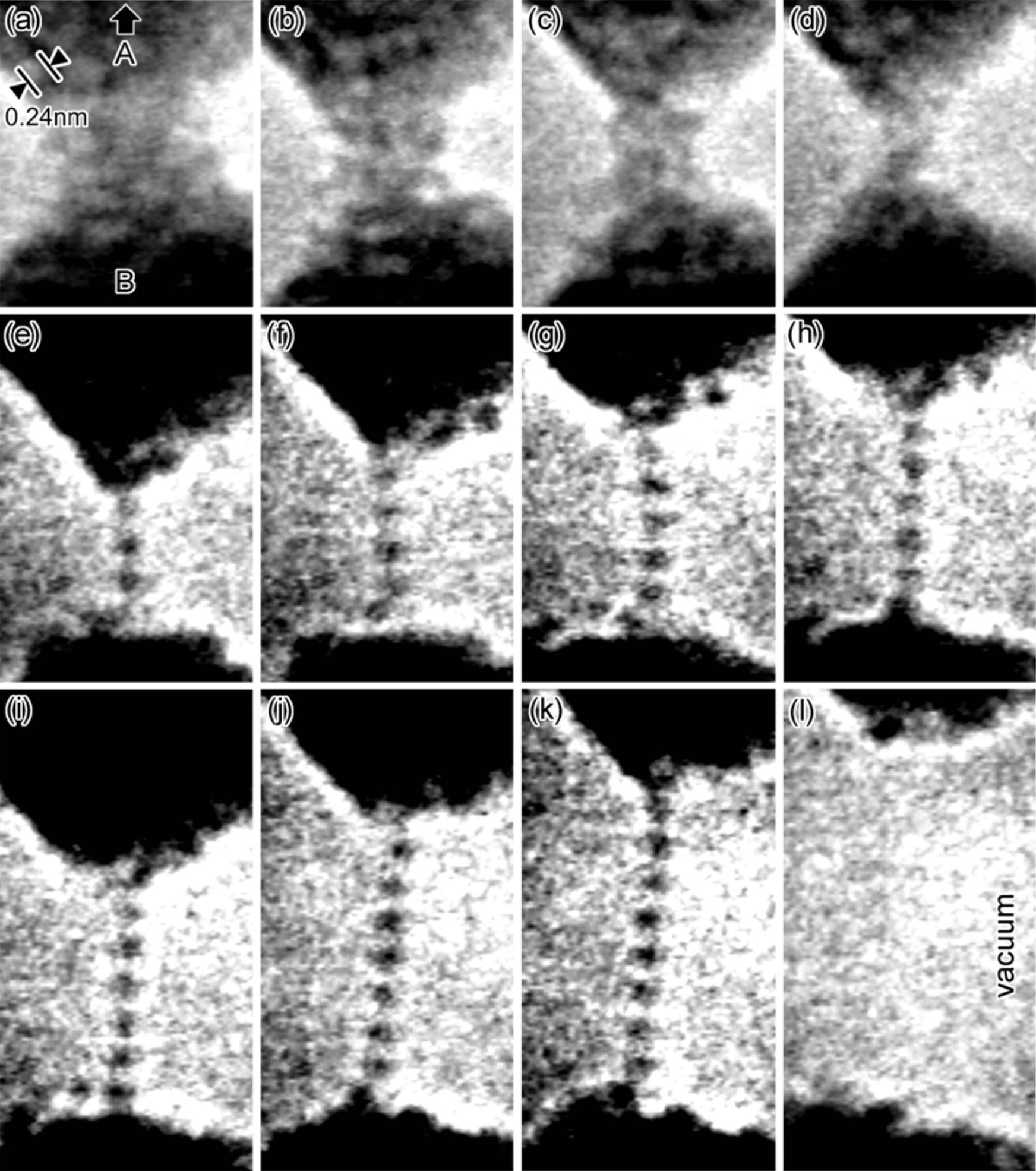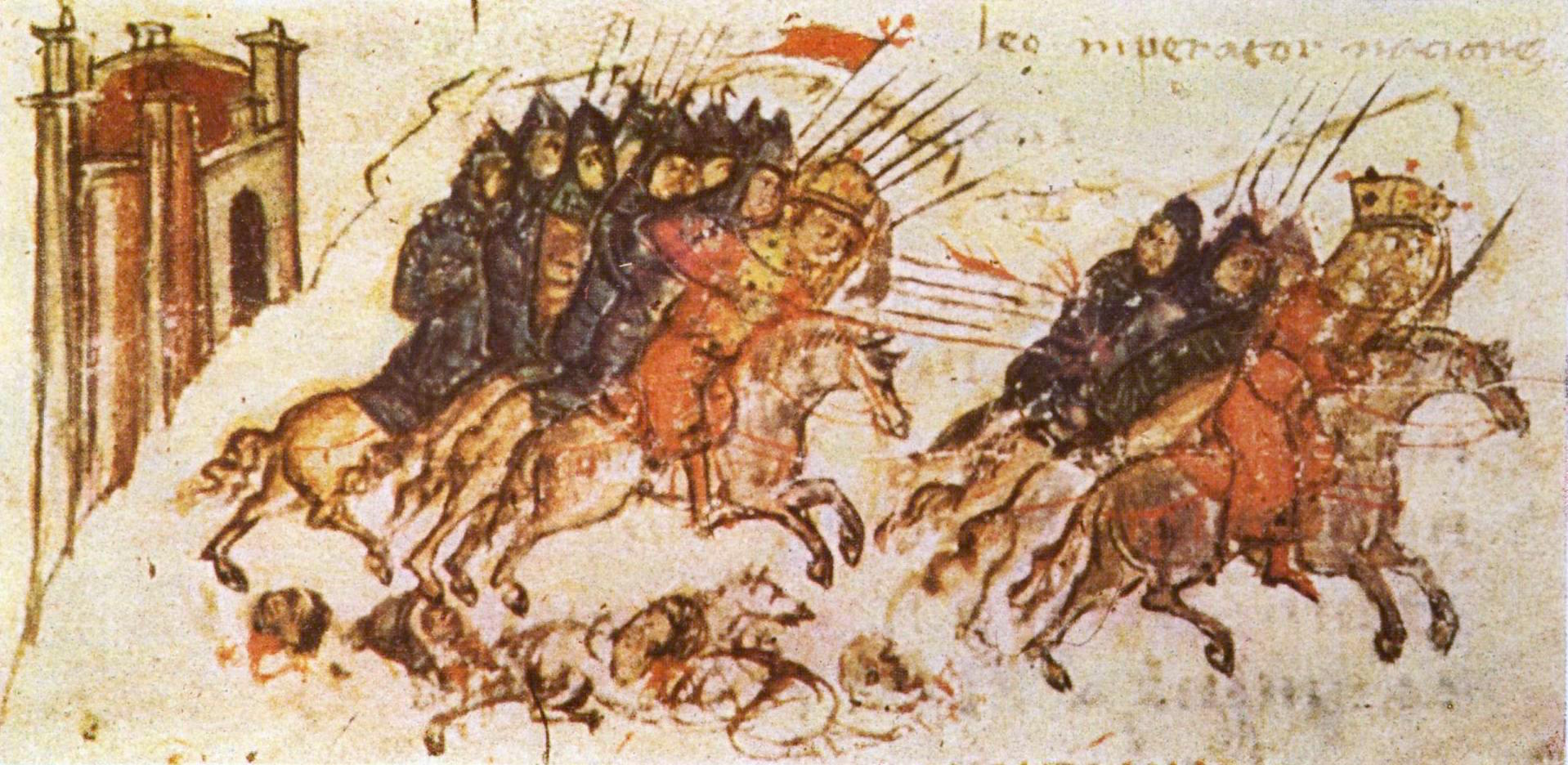|
813
Events By place Byzantine Empire * June 22 – Battle of Versinikia: The Bulgars, led by Krum, ruler (''khan'') of the Bulgarian Empire, defeat Emperor Michael I near Edirne (modern Turkey). The Byzantine army (26,000 men) is destroyed by a counter-attack of Bulgarian heavy cavalry, while trapped in the valley. Krum captures the Byzantine camp and a rich prize, including gold and weaponry. * July 11 – Michael I, under threat by conspiracies, abdicates in favor of his general Leo the Armenian, and becomes a monk (under the name Athanasius). His sons are castrated to prevent them succeeding the Byzantine throne, and relegated into monasteries. One of them, Niketas (renamed Ignatius), eventually becomes a patriarch of Constantinople. * July 17 – Krum reaches Constantinople, and sets his camp outside the walls. He is given an invitation, and a promise of safe conduct, to meet Leo V. Krum sets out unarmed for the capital with only a small escort, but is a ... [...More Info...] [...Related Items...] OR: [Wikipedia] [Google] [Baidu] |
Battle Of Versinikia
The Battle of Versinikia ( bg, Битката при Версиникия; el, Μάχη της Βερσινικίας) was fought in 813 between the Byzantine Empire and the Bulgarian Empire, near the city of Adrianople (Edirne). While the Bulgarians, led by Krum, had an army about half the size of the Byzantine Empire, they were victorious, resulting in the dethroning of Byzantine Emperor Michael I Rangabe (811–813) by Leo V the Armenian. The battle was a major success for the Bulgarians and further strengthened the Bulgarian position after their victory over Nicephorus I two years earlier. After the battle they took ''de facto'' control of the whole of Eastern Thrace (until the Byzantine–Bulgarian Treaty of 815) with the exception of a few castles that remained in Byzantine control. For the first time in Bulgarian history, the way to Constantinople was opened. Krum died at the height of the preparation for the final siege of the Byzantine capital on the 13th of April ... [...More Info...] [...Related Items...] OR: [Wikipedia] [Google] [Baidu] |
Versinikia
The Battle of Versinikia ( bg, Битката при Версиникия; el, Μάχη της Βερσινικίας) was fought in 813 between the Byzantine Empire and the Bulgarian Empire, near the city of Adrianople (Edirne). While the Bulgarians, led by Krum, had an army about half the size of the Byzantine Empire, they were victorious, resulting in the dethroning of Byzantine Emperor Michael I Rangabe (811–813) by Leo V the Armenian. The battle was a major success for the Bulgarians and further strengthened the Bulgarian position after their victory over Nicephorus I two years earlier. After the battle they took ''de facto'' control of the whole of Eastern Thrace (until the Byzantine–Bulgarian Treaty of 815) with the exception of a few castles that remained in Byzantine control. For the first time in Bulgarian history, the way to Constantinople was opened. Krum died at the height of the preparation for the final siege of the Byzantine capital on the 13th of April 814 ... [...More Info...] [...Related Items...] OR: [Wikipedia] [Google] [Baidu] |
Leo V The Armenian
Leo V the Armenian ( gr, Λέων ὁ ἐξ Ἀρμενίας, ''Leōn ho ex Armenias''; 775 – 25 December 820) was the Byzantine emperor from 813 to 820. A senior general, he forced his predecessor, Michael I Rangabe, to abdicate and assumed the throne. He ended the decade-long war with the Bulgars, and initiated the second period of Byzantine Iconoclasm. He was assassinated by supporters of Michael the Amorian, one of his most trusted generals, who succeeded him on the throne. Life Leo was the son of the patrician Bardas, who was of Armenia Armenia (), , group=pron officially the Republic of Armenia,, is a landlocked country in the Armenian Highlands of Western Asia.The UNbr>classification of world regions places Armenia in Western Asia; the CIA World Factbook , , and ...n descent (according to Theophanes Continuatus, Leo was also of Assyrian that is Syrian descent). Leo served in 803 under the rebel general Bardanes Tourkos, whom he deserted in favor of ... [...More Info...] [...Related Items...] OR: [Wikipedia] [Google] [Baidu] |
Michael I Rangabe
Michael I Rhangabe ( gr, Μιχαὴλ Ῥαγγαβέ; ''c''. 770 – 11 January 844) was Byzantine emperor from 811 to 813. Michael was the son of the patrician Theophylact Rhangabe, the admiral of the Aegean fleet. He married Prokopia, the daughter of the former Emperor Nikephoros I, and received the high court dignity of '' kouropalatēs'' after his father-in-law's accession in 802. Life Michael survived Nikephoros' disastrous campaign against Krum of Bulgaria, and was considered a more appropriate candidate for the throne than his severely injured brother-in-law Staurakios. When Michael's wife Prokopia failed to persuade her brother to name Michael as his successor, a group of senior officials (the '' magistros'' Theoktistos, the Domestic of the Schools Stephen, and Patriarch Nikephoros) forced Staurakios to abdicate in his favor on 2 October 811. Michael I attempted to carry out a policy of reconciliation, abandoning the exacting taxation instituted by Nikephor ... [...More Info...] [...Related Items...] OR: [Wikipedia] [Google] [Baidu] |
June 22
Events Pre-1600 *217 BC – Battle of Raphia: Ptolemy IV Philopator of Egypt defeats Antiochus III the Great of the Seleucid kingdom. * 168 BC – Battle of Pydna: Romans under Lucius Aemilius Paullus defeat Macedonian King Perseus who surrenders after the battle, ending the Third Macedonian War. * 813 – Battle of Versinikia: The Bulgars led by Krum defeat the Byzantine army near Edirne. Emperor Michael I is forced to abdicate in favor of Leo V the Armenian. * 910 – The Hungarians defeat the East Frankish army near the Rednitz River, killing its leader Gebhard, Duke of Lotharingia (Lorraine). *1527 – Fatahillah expels Portuguese forces from Sunda Kelapa, now regarded as the foundation of Jakarta. * 1593 – Battle of Sisak: Allied Christian troops defeat the Ottomans. 1601–1900 *1633 – The Holy Office in Rome forces Galileo Galilei to recant his view that the Sun, not the Earth, is the center of the Universe in t ... [...More Info...] [...Related Items...] OR: [Wikipedia] [Google] [Baidu] |
Siege Of Adrianople (813)
The siege of Adrianople ( bg, Обсада на Одрин) in 813 was a part of the wars of the Byzantine Empire with the Bulgarian khan Krum ( Byzantine-Bulgarian Wars). It began soon after the Byzantine field army was defeated in the battle of Versinikia on 22 June. At first the besieging force was commanded by Krum's brother (whose name is not mentioned in the primary sources). The khan himself went on with an army to Constantinople. After an unsuccessful Byzantine attempt to murder him ruined all prospects for negotiations with them, Krum ravaged much of Eastern Thrace and then turned against Adrianople which was still under siege. The city—one of the most important Byzantine fortresses in Thrace—held out for a while despite being attacked with siege engines. Yet, without any help from outside, the garrison was forced to capitulate due to starvation. On Krum's order the population of Adrianople and the surrounding area (numbering about 10,000) was transferred to Bulgaria ... [...More Info...] [...Related Items...] OR: [Wikipedia] [Google] [Baidu] |
Krum
Krum ( bg, Крум, el, Κροῦμος/Kroumos), often referred to as Krum the Fearsome ( bg, Крум Страшни) was the Khan of Bulgaria from sometime between 796 and 803 until his death in 814. During his reign the Bulgarian territory doubled in size, spreading from the middle Danube to the Dnieper and from Odrin to the Tatra Mountains. His able and energetic rule brought law and order to Bulgaria and developed the rudiments of state organization. Biography Origins Krum was a Bulgar chieftain from Pannonia. His family background and the surroundings of his accession are unknown. It has been speculated that Krum might have been a descendant of the old Bulgar royal house of Kubrat. The name Krum is of Turkic origin and means "governor prince" (from '' kurum'' "rule, leadership, administration"). Establishment of new borders Around 805, Krum defeated the Avar Khaganate to destroy the remainder of the Avars and to restore Bulgar authority in Ongal again, the tradition ... [...More Info...] [...Related Items...] OR: [Wikipedia] [Google] [Baidu] |
Castration
Castration is any action, surgical, chemical, or otherwise, by which an individual loses use of the testicles: the male gonad. Surgical castration is bilateral orchiectomy (excision of both testicles), while chemical castration uses pharmaceutical drugs to deactivate the testes. Castration causes sterilization (preventing the castrated person or animal from reproducing); it also greatly reduces the production of hormones, such as testosterone and estrogen. Surgical castration in animals is often called neutering. The term ''castration'' is sometimes also used to refer to the removal of the ovaries in the female, otherwise known as an oophorectomy, or the removal of internal testes, otherwise known as gonadectomy. The equivalent of castration for female animals is spaying. Estrogen levels drop following oophorectomy, and long-term effects of the reduction of sex hormones are significant throughout the body. Castration of animals is intended to favor a desired de ... [...More Info...] [...Related Items...] OR: [Wikipedia] [Google] [Baidu] |
Thrace
Thrace (; el, Θράκη, Thráki; bg, Тракия, Trakiya; tr, Trakya) or Thrake is a geographical and historical region in Southeast Europe, now split among Bulgaria, Greece, and Turkey, which is bounded by the Balkan Mountains to the north, the Aegean Sea to the south, and the Black Sea to the east. It comprises southeastern Bulgaria ( Northern Thrace), northeastern Greece (Western Thrace), and the European part of Turkey (East Thrace). The region's boundaries are based on that of the Roman Province of Thrace; the lands inhabited by the ancient Thracians extended in the north to modern-day Northern Bulgaria and Romania and to the west into the region of Macedonia. Etymology The word ''Thrace'' was first used by the Greeks when referring to the Thracian tribes, from ancient Greek Thrake (Θρᾴκη), descending from ''Thrāix'' (Θρᾷξ). It referred originally to the Thracians, an ancient people inhabiting Southeast Europe. The name ''Europe'' first referred ... [...More Info...] [...Related Items...] OR: [Wikipedia] [Google] [Baidu] |
Gold
Gold is a chemical element with the symbol Au (from la, aurum) and atomic number 79. This makes it one of the higher atomic number elements that occur naturally. It is a bright, slightly orange-yellow, dense, soft, malleable, and ductile metal in a pure form. Chemically, gold is a transition metal and a group 11 element. It is one of the least reactive chemical elements and is solid under standard conditions. Gold often occurs in free elemental (native state), as nuggets or grains, in rocks, veins, and alluvial deposits. It occurs in a solid solution series with the native element silver (as electrum), naturally alloyed with other metals like copper and palladium, and mineral inclusions such as within pyrite. Less commonly, it occurs in minerals as gold compounds, often with tellurium ( gold tellurides). Gold is resistant to most acids, though it does dissolve in aqua regia (a mixture of nitric acid and hydrochloric acid), forming a soluble tetrachloroau ... [...More Info...] [...Related Items...] OR: [Wikipedia] [Google] [Baidu] |
Bulgars
The Bulgars (also Bulghars, Bulgari, Bolgars, Bolghars, Bolgari, Proto-Bulgarians) were Turkic semi-nomadic warrior tribes that flourished in the Pontic–Caspian steppe and the Volga region during the 7th century. They became known as nomadic equestrians in the Volga-Ural region, but some researchers say that their ethnic roots can be traced to Central Asia. During their westward migration across the Eurasian steppe, the Bulgar tribes absorbed other tribal groups and cultural influences in a process of ethnogenesis, including Iranian, Finnic and Hunnic tribes. Modern genetic research on Central Asian Turkic people and ethnic groups related to the Bulgars points to an affiliation with Western Eurasian populations. The Bulgars spoke a Turkic language, i.e. Bulgar language of Oghuric branch. They preserved the military titles, organization and customs of Eurasian steppes, as well as pagan shamanism and belief in the sky deity Tangra. The Bulgars became semi-sedentary du ... [...More Info...] [...Related Items...] OR: [Wikipedia] [Google] [Baidu] |
Khan (title)
Khan ''khan/qan''; tr, han; Azerbaijani: ''xan''; Ottoman: ''han''; Old Turkic: ''kan''; Chinese: 汗 ''hán''; Goguryeo: 皆 ''key''; Buyeo: 加 ''ka''; Silla: 干 ''kan''; Gaya: 旱 ''kan''; Baekje: 瑕 ''ke''; Manchu: ; Persian: خان; Punjabi: ਖ਼ਾਨ; Hindustani: ख़ान or ख़ां (Devanagari), or ( Nastaleeq); Balochi: خان; Bulgarian: хан, ''khan''; Chuvash: хун, ''hun''; Arabic: خان; bn, খান or ) () is a historic Turko-Mongol title originating among nomadic tribes in the Central and Eastern Eurasian Steppe to refer to a chief or ruler. It first appears among the Rouran and then the Göktürks as a variant of khagan (sovereign, emperor) and implied a subordinate ruler. In the Seljuk Empire, it was the highest noble title, ranking above malik (king) and emir (prince). In the Mongol Empire it signified the ruler of a horde (''ulus''), while the ruler of all the Mongols was the khagan or great khan. The title subsequently d ... [...More Info...] [...Related Items...] OR: [Wikipedia] [Google] [Baidu] |




.jpg)



